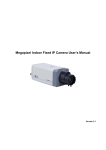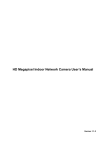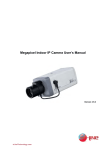Download DNA11xx Series - Dante Security
Transcript
DNA11xx Series MP IP Box Camera Installation and Operations Manual Model Number: DNA1135 (1.3MP), DNA1145 2MP), DNA1165 (3MP), DNA1185 (5MP) Description: MP IP Box Style Cameras Welcome Thank you for purchasing our IP camera! This quick start guide is designed to be a reference tool for your system. Please keep this start guide well for future reference. 1. .Electrical safety All installation and operation here should conform to your local electrical safety codes. The power shall conform to the requirement in the SELV (Safety Extra Low Voltage) and the Limited power source is rated 12V DC or 24V AC in the IEC60950-1. Before you replace the SD card, please unplug the power cable and then remove the shell. We assume no liability or responsibility for all the fires or electrical shock caused by improper handling or installation. We are not liable for any problems caused by unauthorized modifications or attempted repair. 2. .Installation Do not apply power to the IP camera before completing installation. Do not put object on the IP camera. 3. .Environment This series IP camera should be installed in a cool, dry place away from direct sunlight, inflammable, explosive substances and etc. The working temperature ranges from -10℃ to +60℃. Please keep it away from the electromagnetic radiation object and environment. Please keep the sound ventilation. Do not allow the water and other liquid falling into the IP CAM. Thunder-proof device is recommended to be adopted to better prevent thunder. The grounding studs of the product are recommended to be grounded to further enhance the reliability of the camera. 4. Daily Maintenance Current series IP CAM has no power button. Please unplug all corresponding power cables before your installation. Do not touch the CCD or CMOS part; you can use the blower to clean the dust on the surface of the lens. You can use the dry cloth with some alcohol to clear if necessary. Please keep the dustproof cap back to protect the CCD or CMOS part if the IP camera does not work for a long time. If there is too much dust on the housing, please use the water to dilute the mild detergent first and then use it to clean the device with the clear dry cloth. Finally use the dry cloth to clean the device. 5. Accessories Please open the accessory bag to check the items one by one in accordance with the list below. Contact your local retailer ASAP if something is missing or damaged in the bag. i Accessory Name IP Box CAM Unit C/CS adapter Quick Start Guide CD Amount ■ 1 ■ 1 ■ 1 ■ 1 ii Table of Contents 1 2 Framework ............................................................................................................................. 1 1.1 Rear Panel ................................................................................................................ 1 1.2 Side Panel................................................................................................................. 5 1.3 Front Panel ............................................................................................................... 5 Installation .............................................................................................................................. 7 2.1 Lens Installation ....................................................................................................... 7 2.1.1 Auto Aperture Lens ........................................................................................... 7 2.1.2 Manual Lens ...................................................................................................... 7 2.1.3 Remove Lens ..................................................................................................... 8 2.2 SD Card .................................................................................................................... 8 2.2.1 Installation .......................................................................................................... 8 2.2.2 Remove .............................................................................................................. 9 2.3 3G Card..................................................................................................................... 9 2.3.1 Installation .......................................................................................................... 9 2.3.2 Remove ............................................................................................................ 10 2.4 3G/WIFI Antenna ................................................................................................... 11 2.4.1 Installation ........................................................................................................ 11 2.4.2 Remove ............................................................................................................ 12 2.5 I/O Port .................................................................................................................... 12 2.5.1 Install and Remove Cable .............................................................................. 12 2.5.2 Alarm Input and Output................................................................................... 13 3 4 Quick Configuration Tool .................................................................................................... 15 3.1 Overview ................................................................................................................. 15 3.2 Operation ................................................................................................................ 15 Web Operation ..................................................................................................................... 18 4.1 Network Connection............................................................................................... 18 4.2 Login and Logout ................................................................................................... 18 iii Appendix Toxic or Hazardous Materials or Elements ............................................................. 21 iv 1 Framework 1.1 Rear Panel This series DNA11xx IP camera real panel is shown as below. See Figure 1-1. The rear panel with the network port The rear panel with the 100M fiber port Figure 1-1 Please refer to the following sheet for detail information. Interface Name VIDEO OUT Video output port Connector Function BNC Output analog video signal. Can connect to 1 TV monitor to view video. AC 24V/ DC 12V Power port Power port. Input 12V DC or AC 24V STATUS Red light Indication Light System boot upred light is on System upgrades-red light flashes System resetsred light flashes. Green light Normal working status-green light is on. Display record status:Recordgreen light flashes. Yellow light Detect the wireless deviceyellow light is on. 3G Connect to 3G card. Please note it is for 3G series product only. WIFI Antenna port Connect to 3G/WIFI antenna to receive the wireless signal. Please note this function is for some series products only. IN Alarm input port I/O port Alarm input port 1. To receive the signal from 2 the external alarm device. NO Alarm output port Alarm output port. To output alarm signal to C the alarm device. NO: Normal open alarm output end. C: Alarm output public end. G GND Alarm input ground end. A RS485 port RS485_A port, control external PTZ B RS485_B port, control external PTZ RX RS232 port RS232_RX,RS232 receive end. TX RS232_TX,RS232 COM send out end. G GND RS232 ground end NA IR light port External IR light signal control port. RESET RESET button Restore factory default setup. When system is running normally, press the RESET button for at least 5 seconds, system can restore factory default setup. AUDIO OUT Audio output port Audio output 3.5mm Output audio signal to JACK port. the passive device such as earphone. AUDIO IN Audio input port Audio input 3.5mm Input audio signal 3 JACK port. from devices such as pick-up. LAN Network port Ethernet port Connect to standard Ethernet cable. Support PoE function. OPT 100M fiber port 155M single fiber Transmit 100M dual-direction SFP Ethernet data. fiber module SD SD card port Connect to SD card. Note When you install the SD card, please make sure current card is not in write mode and then you can install it to the camera. When you remove the SD card, please make sure current card is not in write mode. Otherwise it may result in data loss or card damage. Before hot swap, please stop record operation. 4 GND Please make sure the device is securely earthed to prevent the thunderstorm strike. 1.2 Side Panel Please refer to the following interface for side panel dimension information. The unit is mm. See Figure 1-2. Figure 1-2 1.3 Front Panel Please refer to the following interface for the front panel information. The unit is mm. See Figure 1-3. 5 Figure 1-3 6 2 Installation 2.1 Lens Installation 2.1.1 Auto Aperture Lens Please follow the steps listed below for auto aperture lens installation. The interface is shown as in Figure 2-1 and Figure 2-2. Remove the CCD protection cap of the device, and then line up the lens to the proper installation position. Turn clockwise until the lens is fixed firmly. Insert the lens cable socket to the auto lens connector in the side panel. Figure 2-1 2.1.2 Manual Lens Install C type lens Remove the CCD protection cap from the device. Install the C/CS adapter to the camera. Turn clockwise to secure against the focusing ring firmly. Line up the C lens to the installation position of the C/CS adapter. Turn clockwise to fix the lens. Use slotted screwdriver to fasten the screw near the focusing ring and then turn counter clockwise to move the focusing ring out for several millimeters. Now you can focus manually and check the video is clear or not. If you can not see the clear video, you can adjust via the flange-back. After you completed the focus setup, use the slotted screwdriver to fix the screw firmly. Fasten the focusing ring. Now the installation completed. Install CS type lens Remove the CCD protection cap from the device. Line up the CS lens to the lens installation position of camera focusing ring. Turn clockwise to fix the lens. Use slotted screwdriver to fasten the screw near the focusing ring and then turn counter clockwise to move the focusing ring out for several millimeters. Now you can focus manually and check the video is clear or not. If you can not see the clear video, you can adjust via the flange-back. After you completed the focus setup, use the slotted screwdriver to fix the screw firmly. Fasten the focusing ring. Now the installation completed. 7 Figure 2-2 2.1.3 Remove Lens Please follow the steps listed below to remove lens. The interface is shown as in Figure 2-3. Turn the lens counter clockwise and then remove it from the camera. Unplug the auto lens cable socket from the auto lens connector. If you are using the manual aperture lens, please skip to the following step. If there is no lens, please put the CCD protection cap back to protect the CCD. Figure 2-3 2.2 SD Card 2.2.1 Installation Please follow the steps listed below to install SD card. The interface is shown as in Figure 2-4 and Figure 2-5. Use the screwdriver to loosen the SD card protection screw in the rear panel, and then remove the SD card protection cap from the camera. Install the SD card to the camera according to the proper installation position. Put the SD card protection cap back. Use the screwdriver to fix the SD card protection cap screw firmly to secure the SD card protection cap in the camera. 8 Figure 2-4 Figure 2-5 2.2.2 Remove Please follow the steps listed below to remove SD card. The interface is shown as Figure 2-6. Use the screwdriver to loosen the screw of SD card protection cap in the rear panel. Remove the cap from the camera. Follow the SD card direction to remove the SD card. Insert the SD card protection cap. Use the screwdriver to fix the screw to secure the protection cap. Figure 2-6 2.3 3G Card 2.3.1 Installation The 3G card installation is the same with the SD card. Please follow the steps listed below to install 3G card. The interfaces are shown as Figure 2-7 and Figure 2-8. 9 Use the screwdriver to loosen the 3G card protection cap screw in the side panel, and then remove the 3G card protection cap from the camera. Install the 3G card to the camera according to the proper installation position. Put the 3G card protection cap back. Use the screwdriver to fix the 3G card protection cap screw firmly to secure the 3G card protection cap. Figure 2-7 Figure 2-8 2.3.2 Remove Please follow the steps listed below to remove 3G card. The interface is shown as Figure 2-9. Use the screwdriver to loosen the screw of 3G card protection cap in the rear panel. Remove the cap from the camera. Follow the 3G card direction to remove the 3G card. Insert the 3G card protection cap. Use the screwdriver to fix the screw to secure the protection cap. Figure 2-9 10 2.4 3G/WIFI Antenna 2.4.1 Installation Line up the thread of the screw of the 3G/WIFI antenna to the thread of the rear panel. See Figure 2-10. Please turn according to the direction in the following figure until antenna is secure firmly. See Figure 2-11. Figure 2-10 Figure 2-11 After you fix the 3G/WIFI antenna to the WIFI port of the rear panel, you can adjust the antenna direction. See Figure 2-12. Figure 2-12 11 2.4.2 Remove Use your hands to hold the 3G/WIFI thread end and then turn according to the following figure. See Figure 2-13. Now you can see the antenna is away from the thread. See Figure 2-14. Figure 2-13 Figure 2-14 Remove the 3G/WIFI antenna from the port of the rear panel. See Figure 2-15. Figure 2-15 2.5 I/O Port 2.5.1 Install and Remove Cable Install Cable 12 Please follow the steps listed below to install the cable. See Figure 2-16. Use the small slotted screwdriver to press the corresponding button of cable groove. Insert the cable into the groove and then release the screwdriver. Remove Cable Please follow the steps listed below to remove the cable. Use the small slotted screwdriver to press the corresponding button of cable groove. Remove the cable out of the groove and then release the screwdriver. Figure 2-16 2.5.2 Alarm Input and Output Please refer to the following figure for alarm input information. See Figure 2-17. Alarm input: When the input signal is idle or grounded, the device can collect the different statuses of the alarm input port. When the input signal is connected to the 5V or is idle, the device collects the logic “1”. When the input signal is grounded, the device collects the logic “0”. Figure 2-17 Please refer to the following figure for alarm output information. See Figure 2-18. Port NO and Port C composes an on-off button to provide the alarm output. If the type is NO, this button is normal open. The button becomes on when there is an alarm output. If the type is NC, this button is normal off. The button becomes off when there is an alarm output. Figure 2-18 13 Please refer to the following figure for external IR light information. See Figure 2-19. IR synchronization input signal. When the external IR light is on, the signal cable from the board outputs the 3.3V/1mA. It outputs the 0V when the IR light is off. Figure 2-19 14 3 Quick Configuration Tool 3.1 Overview Quick configuration tool can search current IP address, modify IP address. At the same time, you can use it to upgrade the device. Please note the tool only applies to the IP addresses in the same segment. 3.2 Operation Double click the “ConfigTools.exe” icon; you can see an interface is shown as in Figure 3-1. In the device list interface, you can view device IP address, port number, subnet mask, default gateway, MAC address and etc. Figure 3-1 Select one IP address and then right click mouse, you can see an interface is shown as in Figure 3-2. Figure 3-2 15 Select the “Open Device Web” item; you can go to the corresponding web login interface. See Figure 3-3. Figure 3-3 If you want to modify the device IP address without logging in the device web interface, you can go to the configuration tool main interface to set. In the configuration tool search interface (Figure 3-1), please select a device IP address and then double click it to open the login interface. Or you can select an IP address and then click the Login button to go to the login interface. See Figure 3-4. In Figure 3-4, you can view device IP address, user name, password and port. Please modify the corresponding information to login. Please note the port information here shall be identical with the port value you set in TCP port in Web Network interface. Otherwise, you cannot login the device. If you are use device background upgrade port 3800 to login, other setups are all invalid. Figure 3-4 After you logged in, the configuration tool main interface is shown as below. See Figure 3-5. 16 Figure 3-5 For detailed information and operation instruction of the quick configuration tool, please refer to the Quick Configuration Tool User’s Manual included in the resources CD. 17 4 Web Operation This series IP CAM product support the Web access and management via PC. Web includes several modules: monitor channel preview, PTZ control, system configuration, alarm and etc. 4.1 Network Connection Please follow the steps listed below for network connection. Make sure the IP CAM has connected to the network properly. Please set the IP address, subnet mask and gateway of the PC and the IP CAM respectively. IP CAM default IP address is 192.168.1.108. Subnet mask is 255.255.255.0. Gateway is 192.168.1.1. Use order ping ***.***.***.***(* IP camera address) to check connection is OK or not. 4.2 Login and Logout Open IE and input IP camera address in the address bar. For example, if your camera IP is 192.168.1.108, then please input http:// 192.168.1.108 in IE address bar. See Figure 4-1. Input your IP address here Figure 4-1 The login interface is shown as below. See Figure 4-2. Please input your user name and password. Default factory name is admin and password is admin. Note: For security reasons, please modify your password after you first login. 18 Figure 4-2 If it is your first time to login in, system pops up warning information to ask you whether install control webrec.cab or not after you logged in for one minute. Please click OK button, system can automatically install the control. When system is upgrading, it can overwrite the previous Web too. If you can’t download the ActiveX file, please check whether you have installed the plug-in to disable the control download. Or you can lower the IE security level. See Figure 4-3. Figure 4-3 After you logged in, you can see the main window. See Figure 4-4. 19 Figure 4-4 Please refer to the Web Operation Manual included in the resource CD for detailed operation instruction. 20 Appendix Toxic or Hazardous Materials or Elements Component Name Toxic or Hazardous Materials or Elements Pb Hg Cd Cr VI PBB PBDE Circuit Board Component ○ ○ ○ ○ ○ ○ Device Construction Material ○ ○ ○ ○ ○ ○ Wire and Cable ○ ○ ○ ○ ○ ○ Power Adapter ○ ○ ○ ○ ○ ○ Packing Components ○ ○ ○ ○ ○ ○ Accessories ○ ○ ○ ○ ○ ○ O: Indicates that the concentration of the hazardous substance in all homogeneous materials in the parts is below the relevant threshold of the SJ/T11363-2006 standard. X: Indicates that the concentration of the hazardous substance of at least one of all homogeneous materials in the parts is above the relevant threshold of the SJ/T11363-2006 standard. During the environmental-friendly use period (EFUP) period, the toxic or hazardous substance or elements contained in products will not leak or mutate so that the use of these (substances or elements) will not result in any severe environmental pollution, any bodily injury or damage to any assets. The consumer is not authorized to process such kind of substances or elements, please return to the corresponding local authorities to process according to your local government statutes. Note: This quick start guide is for reference only. Slight difference may be found in user interface. All the designs and software here are subject to change without prior written notice. If there is any uncertainty or controversy, please refer to the final explanation of us. Please visit our website or contact your local service engineer for more information. 21







































